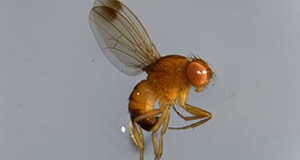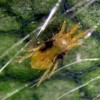
Spotted wing drosophila, Drosophila suzukii (Matsumura) (Diptera: Drosophilidae), is an invasive pest that was introduced into Florida in 2009. Spotted wing drosophila survives well under Florida’s climatic conditions. In 2014, losses to berry crops in Florida were estimated at $35 million. Losses are due to maggot-infested fruit, which is unacceptable for the fresh berry market, and puncture holes in the fruit made by egg-laying females. The holes lead to secondary infection by fungal and bacterial pathogens. This 4-page fact sheet written by Lindsy E. Iglesias, James F. Price, Craig R. Roubos, Justin M. Renkema, and Oscar E. Liburd and published by the Department of Entomology and Nematology describes the flies and some strategies to identify them and manage them in berry operations.
http://edis.ifas.ufl.edu/in839
Tag: James F. Price
Pesticide Options for Insect, Mite, and Mollusk Management in Commercial Strawberry Production in Florida (ENY689/IN486)
 Effective management of arthropod and gastropod pests of strawberry is critical to the profitability of the industry and requires that pests be detected in a timely manner through systematic scouting. Appropriate control measures should be applied as conditions warrant. The tables in this 22-page fact sheet list pesticides that are presently available to commercial strawberry producers in Florida and are organized alphabetically by major pest groups. Written by James F. Price, Curtis Nagle, and Susan E. Webb, and published by the UF Department of Entomology and Nematology, April 2013.
Effective management of arthropod and gastropod pests of strawberry is critical to the profitability of the industry and requires that pests be detected in a timely manner through systematic scouting. Appropriate control measures should be applied as conditions warrant. The tables in this 22-page fact sheet list pesticides that are presently available to commercial strawberry producers in Florida and are organized alphabetically by major pest groups. Written by James F. Price, Curtis Nagle, and Susan E. Webb, and published by the UF Department of Entomology and Nematology, April 2013.
http://edis.ifas.ufl.edu/in486
Causes and Management of Insect and Mite Resistance in Strawberry Production (ENY841/IN713)
 Episodes of pest resistance to popular pesticides can cause yield losses, reduction of fruit quality, added control costs, environmental degradation, and emotional stress among farmers. These consequences can be alleviated if resistance management is practiced throughout the strawberry industry. If they minimize pesticide application by depending more on biological and cultural pest control measures, and take care not to expose pest populations to pesticides with identical modes of action, growers can avoid causing pesticide resistance. This 8-page fact sheet was written by James F. Price and Curtis Nagle, and published by the UF Department of Entomology and Nematology, November 2012.
Episodes of pest resistance to popular pesticides can cause yield losses, reduction of fruit quality, added control costs, environmental degradation, and emotional stress among farmers. These consequences can be alleviated if resistance management is practiced throughout the strawberry industry. If they minimize pesticide application by depending more on biological and cultural pest control measures, and take care not to expose pest populations to pesticides with identical modes of action, growers can avoid causing pesticide resistance. This 8-page fact sheet was written by James F. Price and Curtis Nagle, and published by the UF Department of Entomology and Nematology, November 2012.
http://edis.ifas.ufl.edu/in713
Management of Insect and Mite Resistance in Ornamental Crops (ENY843/IN715)
 Resistance of arthropods to crop management chemicals has been problematic since the early era of synthetic organic pesticides. During the 1970s and early 1980s leafminer outbreaks heavily damaged herbaceous ornamental crops such as chrysanthemum, gypsophila, aster, and marigold in fields, shade houses and greenhouses. Several effective insecticides including organophosphates, carbamates, pyrethroids, and a triazine were identified for leafminer control during the outbreak; however, control was short-lived as the leafminer developed resistance to each insecticide.This 11-page fact sheet was written by James F. Price, Elzie McCord, Jr., and Curtis Nagle, and published by the UF Department of Entomology and Nematology, November 2012.
Resistance of arthropods to crop management chemicals has been problematic since the early era of synthetic organic pesticides. During the 1970s and early 1980s leafminer outbreaks heavily damaged herbaceous ornamental crops such as chrysanthemum, gypsophila, aster, and marigold in fields, shade houses and greenhouses. Several effective insecticides including organophosphates, carbamates, pyrethroids, and a triazine were identified for leafminer control during the outbreak; however, control was short-lived as the leafminer developed resistance to each insecticide.This 11-page fact sheet was written by James F. Price, Elzie McCord, Jr., and Curtis Nagle, and published by the UF Department of Entomology and Nematology, November 2012.
http://edis.ifas.ufl.edu/in715
Pesticide Options for Important Insect, Mite, and Mollusk Pests of Commercial Flowers in Florida (ENY695/IG162)
 Effective arthropod pest management in commercial floral crops requires that pests be detected in a timely manner through systematic scouting and that appropriate control measures be applied as conditions warrant. Control measures may include economical combinations of cultural controls, physical controls, biological controls, and chemical controls. This 9-page guide is a summary of chemical control measures that are presently available to commercial flower producers in Florida and includes beneficial nematode and microbial insecticides that also are components of biological control. Written by James F. Price and Curtis Nagle, and published by the UF Department of Entomology and Nematology, November 2012.
Effective arthropod pest management in commercial floral crops requires that pests be detected in a timely manner through systematic scouting and that appropriate control measures be applied as conditions warrant. Control measures may include economical combinations of cultural controls, physical controls, biological controls, and chemical controls. This 9-page guide is a summary of chemical control measures that are presently available to commercial flower producers in Florida and includes beneficial nematode and microbial insecticides that also are components of biological control. Written by James F. Price and Curtis Nagle, and published by the UF Department of Entomology and Nematology, November 2012.
http://edis.ifas.ufl.edu/ig162
ENY857/IN839 Spotted Wing Drosophila New in Florida Berry Culture
ENY857, a 3-page illustrated fact sheet by James F. Price and Curtis A. Nagle, describes this pest of strawberry, blueberry, raspberry and other thin-skinned fruit that was discovered in Hillsborough County in August 2009, and which strawberry growers should be prepared to encounter in winter 2010. It describes possible tactics for management. Includes references and a table of insecticides available for management of Drosophila spp. flies on strawberries in Florida. Published by the UF Department of Entomology and Nematology, October 2009.
http://edis.ifas.ufl.edu/IN839
ENY307/IG008 Insect and Mite Management Suggestions for Commercial Poinsettia Production
Revised! ENY-307, a 96-page guide by James F. Price, Curtis Nagle and Elzie McCord, Jr., aids in the selection of insect and mite control measures for commercial producers of this flower that is synonymous with Christmas. Published by the UF Department of Entomology and Nematology, December 2008.
http://edis.ifas.ufl.edu/IG008
ENY310/IG011 Insect and Mite Management Suggestions for Commercial, Field-grown Statice Production
Revised! ENY-310, a 30 page fact sheet by James F. Price, Curtis Nagle and Elzie McCord, Jr., provides a guide to facilitate selection of pesticides for field production of this winter flower crop in Florida. Published by the UF Department of Entomology and Nematology, December 2008.
http://edis.ifas.ufl.edu/IG011
HS1154/HS403 Growing Strawberries in the Florida Home Garden
HS-1154, a 4-page illustrated fact sheet by Craig K. Chandler, James F. Price, Natalia A. Peres, and Bielinski M. Santos, provides home gardeners with information about strawberry growing conditions and varieties for Florida, soil preparation and plant establishment, freeze protection, pest management, and harvesting and storage. It replaces HS509/VH029, Strawberries in the Florida Garden, by James M. Stephens. Published by the UF Department of Horticultural Sciences, December 2008.
http://edis.ifas.ufl.edu/HS403
ENY-750/IN773 A Dresser Drawer Method of Managing Insect and Mite Resistance in Ornamentals
ENY-750, a 2-page fact sheet by James F. Price and Curtis A. Nagle, describes a dresser drawer method to develop pesticide rotation plans that can extend the useful lives of pesticides. Published by the UF Department of Entomology and Nematology, July 2008.
http://edis.ifas.ufl.edu/IN773